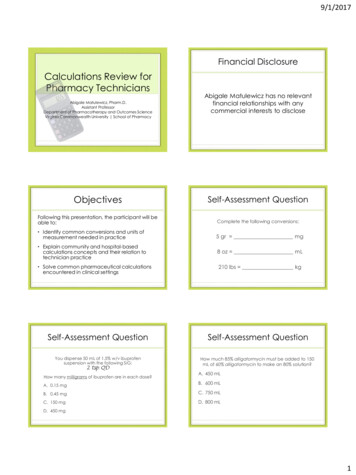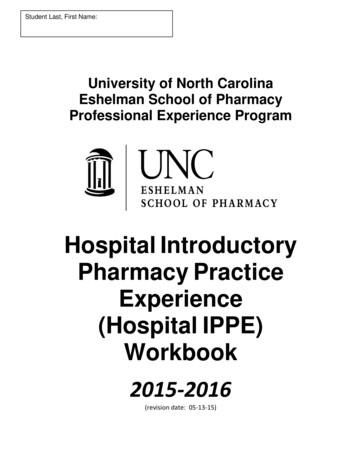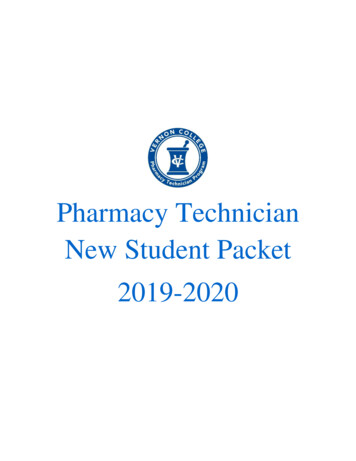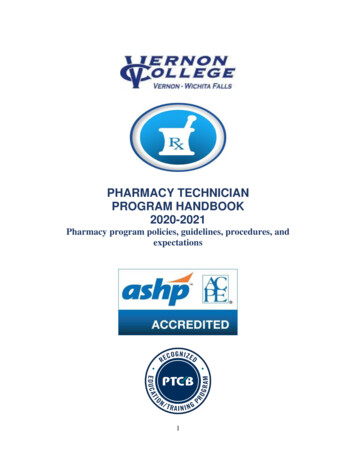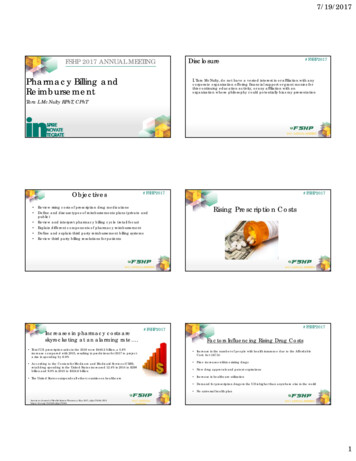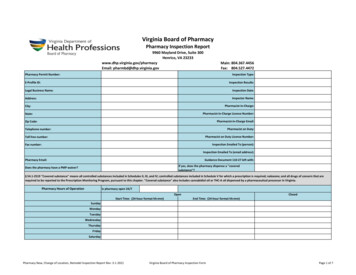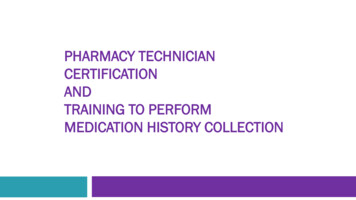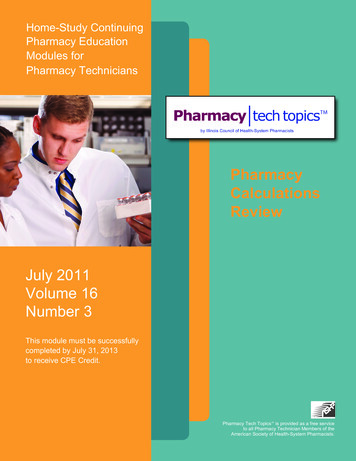
Transcription
Home-Study ContinuingPharmacy EducationModules forPharmacy TechniciansPharmacyCalculationsReviewJuly 2011Volume 16Number 3This module must be successfullycompleted by July 31, 2013to receive CPE Credit.Pharmacy Tech Topics is provided as a free serviceto all Pharmacy Technician Members of theAmerican Society of Health-System Pharmacists.
Pharmacy Tech Topics Volume 16 Number 3July 2011Pharmacy Calculations ReviewAUTHOR: Yolanda M. Hardy, PharmDEDITOR: Patricia M. Wegner, PharmD, FASHPDESIGN EDITOR: Stephanie LammiPharmacy Tech Topics (USPS No. 014-766) is published quarterly for 50 per year bythe Illinois Council of Health-System Pharmacists, 4055 N. Perryville Road, Loves Park, IL 61111-8653.Phone (815) 227-9292. Periodicals Postage Paid at Rockford, IL and additional mailing offices.POSTMASTER: Send address changes to:Pharmacy Tech Topics , c/o ICHP, 4055 N. Perryville Road, Loves Park, IL 61111-8653Copyright July 2011All contents 2011 Illinois Council of Health-System Pharmacists unless otherwise noted. All rights reserved.Pharmacy Tech Topics is a trademark of the Illinois Council of Health-System Pharmacists.This module is accredited for 2.5 contact hours of continuing pharmacy education and is recognized by thePharmacy Technician Certification Board (PTCB).LEARNING OBJECTIVESUpon completion of this module, the subscriber will be able to:1.2.3.4.5.6.Compute pharmacy problems by using ratio and proportion or dimensional analysis.Compare and convert units among the pharmacy math systems, especially the metric system.Calculate quantity and day supply.Calculate doses based on weight and body surface area.Calculate intravenous (IV) flow rates.Reduce and enlarge compounding formulas.Accreditation: Pharmacy Tech Topics Modules are accredited for Continuing Pharmacy Education (CPE) credits by theIllinois Council of Health-System Pharmacists. The Illinois Council of Health-System Pharmacists is accredited by theAccreditation Council for Pharmacy Education as a provider of continuing pharmacy education. 2011 Illinois Council ofHealth-System Pharmacists. Pharmacy Tech Topics is a trademark of the Illinois Council of Health-System Pharmacists.The intended audience is pharmacy technicians.This module will provide 2.5 contact hours of continuing pharmacy education credit for pharmacy technicians.ACPE Universal Activity Number: 121-000-11-003-H04-TValidation Dates: 07/01/11 to 07/31/13Type of Activity: Knowledge
Pharmacy Calculations ReviewMEET THE AUTHORYolanda M. Hardy, PharmDAssistant Professor of Pharmacy PracticeChicago State University College of PharmacyChicago, ILDr. Yolanda M. Hardy is an Assistant Professor of Pharmacy Practice at Chicago State University College of Pharmacy.She is also an adjunct professor at South Suburban College, where she teaches pharmacy calculations in the pharmacytechnician program. Dr. Hardy holds a Bachelor of Science in Pharmacy degree from the University of Toledo in Toledo, Ohio (1999). She earned a Doctor of Pharmacy degree at The Ohio State University in Columbus, Ohio (2001).Following this, she completed a Pharmacy Practice Residency in Community Care with The Ohio State UniversitySchool of Pharmacy and the Columbus Neighborhood Health Centers, Inc. in Columbus, Ohio. She served on thefaculty of Northeastern University School of Pharmacy in Boston, Massachusetts from 2002-2008.PHARMACY TECH TOPICS JULY 2011 FACULTY DISCLOSUREIt is the policy of the Illinois Council of Health-System Pharmacists (ICHP) to insure balance and objectivity in allits individually or jointly presented continuing pharmacy education programs. All faculty participating in any ICHPcontinuing pharmacy education programs are expected to disclose any real or apparent conflict(s) of interest that mayhave any bearing on the subject matter of the continuing pharmacy education program. Disclosure pertains to relationships with any pharmaceutical companies, biomedical device manufacturers, or other corporations whose products orservices are related to the subject matter of the topic.The intent of disclosure is not to prevent the use of faculty with a potential conflict of interest from authoring a publication but to let the readers know about the relationship prior to participation in the continuing pharmacy educationactivity. It is intended to identify financial interests and affiliations so that, with full disclosure of the facts, the readersmay form their own judgments about the content of the learning activity.Dr. Hardy’s submission has been peer reviewed with consideration and knowledge of these potential conflicts and it hasbeen found to be balanced and objective. The author has no real or apparent conflict(s) of interest that may have anybearing on the subject matter of this continuing pharmacy education program.NOTICEMedicine is an ever-changing science. As new research and clinical experience broaden our knowledge, changes in treatment and drug therapy are required.The author and the publisher of this work have checked with sources believed to be reliable in their efforts to provideinformation that is complete and generally in accord with the standards accepted at the time of publication. However, inview of the possibility of human error or changes in medical sciences, neither the author nor the publisher nor any otherparty who has been involved in the preparation or publication of this work warrants that the information contained hereinis in every respect accurate or complete, and they are not responsible for any errors or omissions or for the results obtainedfrom use of such information.Readers are encouraged to confirm the information contained herein with other sources. For example and in particular,readers are advised to check the product information sheet included in the package of each drug they plan to administerto be certain that the information contained in this module is accurate and that changes have not been made in the recommended dose or in the contraindications for administration. This recommendation is of particular importance in connection with new or infrequently used drugs.3
PHARMACY TECH TOPICS — JULY 2011TMModule ContentsIntroductionIntroductionCorrect pharmacy calculations are imperative to the practice of pharmacy. From thecalculation of amounts of components being added to a compounded total parenteralnutrition (TPN) to the drops per minute rate on the label of an intravenous (IV) bag,pharmacy calculations can make a difference of life or death.Unit 1:Basic Calculation Foundation:Ratio and Proportion andDimensional AnalysisUnit 2:Measurement Systems Usedin the Practice of PharmacyUnit 3:Calculation of Quantity andDay SupplyUnit 4:Calculation of DosesUnit 5:IV Flow RatesUnit 6:Reducing and EnlargingFormulasStriving for Accuracy inPharmacy CalculationsTips to help minimize calculations errorsPharmacy CalculationPractice ResourcesBeing a pharmacy technician requires a variety of skills and abilities and perhaps mostimportant is the ability to carry out important mathematic calculations. The goal of thismodule is to provide a basic review of the many types of pharmacy calculations that pharmacy technicians are asked to perform.Unit 1: Basic Calculation FoundationRatio and Proportion and Dimensional Analysis1Ratio and ProportionRatio and proportion calculations are based on the concept that one component is in proportion to another. As a result, many calculations may be solved by setting the problemup as a ratio.For example: 1 tablet contains 500mg. “One tablet contains 500mg” is the same as saying“500mg per 1 tablet”. Thus, this can be written as:500mg or 1 tab1 tab500mgUsing proportions we can determine a ratio that is equal to this ratio.Example 1: If 1 tablet contains 500mg, how many milligrams are in 3 tablets?500mg Xmg1 tab3 tabSolving for x, we find that there are 1500mg in 3 tablets. Because we used proportions, weknow that the ratio of:500mg is equal to 1500mgor1 tab3 tab500mg 1 tab1500mg3 tabExample 2: If one teaspoonful (5ml) of a solution contains 15mg of medication, how manymilligrams are there in 4 teaspoonsful or 20ml?15mg Xmg5ml20ml15mg x 20ml Xmg x 5ml15mg x 20ml Xmg x 5ml5ml5ml300mg Xmg5160mg XmgSo there are 60mg in 20mls or 4 teaspoons of the solution.4
Pharmacy Calculations ReviewDimensional Analysis*A Word About RoundingDimensional Analysis is another method that may be used to calculate quantities of IVadditives or strengths of doses. This method is based on cancelling out the units of measure or labels.Example 1: If 1 tablet contains 500mg, how many milligrams are in 3 tablets?Step 1: Find the ratio that is in the problem. In this case, the ratio is:500mg1 tabStep 2: Set up the problem around the ratio so that the units cancel out. Theunit that is left (ie. the unit that does not cancel out with the other units) shouldcorrespond to the unit needed for the answer to the problem. In this problem,the unit that we need is ‘mg’, since the problem asks how many milligrams are in3 tablets.3 tab x 500mg 1500mg1 tabExample 2: A pharmacy technician must fill an order for three 1 liter bags of 5% dextrosein water (D5W) with 12mmols of potassium phosphate for one patient. The potassiumphosphate is 3mmol/ml in 5ml vials. How many 5ml vials of potassium phosphate will thetechnician need to fill the patient’s order?3 bags x 12mmols x 1ml x 1 vialbag3mmol 5ml 2.4 vialsPractice1. A prescription for a suspension calls for a dose of 250mg to be given twice a day. If thesuspension contains 300mg/5ml, how many ml are needed for one dose?2. A prescription calls for 2000mg of amoxicillin for one dose. If the pharmacy only carries 250mg capsules of amoxicillin, how many capsules will you need to fill this dose?3. A patient injects 8 units of U-100 insulin each day. What is the volume in millilitersthe patient needs to inject? (Hint: U-100 100units of insulin/ml)4. An order is written for 375mg of ampicillin to be given intraveneously every 6 hours toa child weighing 15kg. Ampicillin is available in a 1g/50ml concentration. Calculatethe volume in milliliters needed for a single 375mg dose.Often, it is more practical toround a number to the nearest whole number, tenth, orhundredth decimal place.When rounding, it is important to follow this rule: Ifthe number to the right ofthe place for which you arerounding is less than 5, rounddown. If the number is 5 orgreater, round up. For example, the answer to Practice Question 1 is actually4.17 ml. Because it would bevery difficult to measure thisexact amount in an oral syringe, it is more practical toround the amount to a volume that is more practicalto obtain. If we are using anoral syringe that measuresto the tenths place, we couldround the volume to thenearest tenth. Because thenumber to the right of thetenths place is greater than5 (it is 7), we would roundup, making the value 4.2ml.If we were to round to thenearest whole number, thevalue would be 4, since thenumber to the right of thewhole number is less than 5(it is 1).Practice AnswersQuestion 1: 4.2ml*; Question2: 8 capsules; Question 3:0.08ml; Question 4: 18.75mlQuestion 5: 40ml; Question 6:200,000 units; Question 7: 15units5. An order is written for 2g of vancomycin to be given IV every 12 hours for an adult.Calculate the volume in milliliters needed for a single dose if vancomycin is availablein a 50mg/ml concentration.6. If there are 400,000 units of penicillin in 250mg of penicillin V potassium, how manyunits of penicillin will a patient receive in a 125mg dose of penicillin V potassium?7. A patient injects 0.15 ml of insulin each morning. How many units of insulin are ineach dose? (Hint: 100units of insulin/ml)5
PHARMACY TECH TOPICS — JULY 2011TMUnit 2: Measurement Systems Used in the Practice ofPharmacy2The Metric SystemThe metric system, also known as the International System of Units (SI), is a measurementsystem that pharmacists and technicians must know. The system uses ‘units’ and ‘prefixes’.The ‘units’ most commonly used in the practice of pharmacy include:Gram (used as a measure of weight or drug strength)Meter (used as a measure of distance or area)Liter (used as a measure of volume)These are sometimes referred to as the ‘base unit’.The ‘prefixes’ most commonly used in the practice of pharmacy include:KiloMilliMicroNanoIn the SI system, a prefix is paired with a base unit to help describe a measurement.Examples:Kilo GramKilogramMilli LiterMilliliterMetric System: GramsUnderstanding FactorsEach prefix representsa power of 10 from thebase unit.(Note: Units of measure in bold are most commonly used in pharmacy practice)Prefix Name Factor ValueKilo Kilogram(Kg) 1031,000 gramsHecto Hectogram (hg) 102100 gramsDeka Dekagram 10110 gramsGram (g) 1 gramDeci Decigram (dg) 10-10.1 gramCenti Centigram 10-20.01 gramMilliMilligram (mg)10-30.001 gram-6Micro Microgram (mcg)100.000001 gramNano Nanogram (ng) 10-90.000000001 gramMetric System: Liters(Note: Units of measure in bold are most commonly used in pharmacy practice)Prefix Name Factor ValueKilo Kiloliter (KL) 1031,000 litersHecto Hectoliter (hL) 102100 liters1Deka Dekaliter 1010 litersLiter (L) 1 literDeci Deciliter (dL) 10-10.1 liter-2Centi Centiliter 100.01 literMilliMilliliter (mL or ml) 10-30.001 literMicro Microliter (mcL)10-60.000001 liter-9Nano Nanoliter (nL) 100.000000001 liter6
Pharmacy Calculations ReviewMetric System: Meters(Note: Units of measure in bold are most commonly used in pharmacy practice)Prefix Name Factor ValueKilo Kilometer (Km) 1031,000 meters2HectoHectometer (hm)10100 metersDeka Dekameter 10110 metersMeter (m) 1 meterDeci Decimeter(dm) 10-10.1 meter-2CentiCentimeter (cm)100.01 meterMilliMillimeter (mm)10-30.001 meter-6Micro Micrometer (mcm)100.000001 meterNanoNanometer (nm)10-90.000000001 meterConverting Units within the Metric SystemThere are a number of ways to convert between units in the metric system. Here are acouple of examples.Method #1Metric System ScaleNanoMicroMilliCentiDeciGramDekaHectoKiloThe smaller hash marks represent units that are not typically used in pharmacy. Pleasedo not forget that these hashmarks also represent units!Using the scale above, one can convert between units by following these directions:1. Locate the prefix or unit that matches the unit that is given to you.2. Locate the prefix or unit that matches the unit that is desired.3. Count the number of units it takes to get to the desired unit, starting from thegiven unit. Note the direction you have to move to get to the desired unit. Thiswill tell you how many spaces to move the decimal point of the number writtenbefore the unit that is given. If you move to the left to get to the desired unit, movethe decimal point to the left. If you move to the right to get to the desired unit,move the decimal point to the right. Use zeros “0” as place holders.4. Add the new unit to the numerical value.Example: Convert 3g to kg.Step 1: Locate prefix or unit that is given.NanoMicroMilliCentiDeciGramDekaHectoKilo7
PHARMACY TECH TOPICS — JULY 2011TMStep 2: Locate the prefix or unit that matches the unit that is ep 3: Count the number of units between step 1 and step 2.I have to move 3 units to get to the desired unit. I have to move to the left. Therefore, Imove the decimal point to the left. 0 . 0 . 3 .In pharmacy, it is imperative to include a leading zero, to help reduce medicationerrors. Therefore, this value is written as:0.003Step 4: 3g is equivalent to 0.003kgMethod #2Remembering the following conversions can also help in converting within the metric system:1kg 1000g1g 1000mg1g 1,000,000mcg1g 1,000,000,000ngKeeping this in mind, you can use ratio and proportion or dimensional analysis to convertwithin the metric system.Example: Convert 5kg to mg.Ratio and Proportion5kg 1kgXg1000gSolving for x:x 5000gThenDimensional Analysis5kg x 1000g x 1000mg 5,000,000mg1kg1g85000g 1gXmg1000mgSolving for X:X 5,000,000mg
Pharmacy Calculations ReviewPracticePractice AnswersQuestion 1: 0.003g; Question2: 5400ml; Question 3: 0.014m; Question 4: 0.03L; Question5: 6,000,000,000ng; Question6: 12g; Question 7: 0.1ml;Question 8: 0.013kg; Question9: 26,000mg; Question 10:640,000mclComplete the following conversions:1.2.3.4.5.6.7.8.9.10.3mg g5.4L ml14mm m30ml L6g ng12,000,000mcg g100mcl ml13g kg26g mg640ml mclApothecary SystemAnother measurement system used in pharmacy is the apothecary system. The apothecarysystem can be used for fluid measurements and weight measurements. Converting withinthe apothecary system may be done using ratio and proportion or dimensional analysis.Apothecary Conversions:Fluid Measures60 minims 1 fluidrachm or fluidram 8 fluidrams 480 minims 1 fluidounce (fl oz)16 fluidounces 1 pint (pt)2 pints 32 fluidounces 1 quart (qt)4 quarts 8 pints 1 gallon (gal)Weight Measures20 grains 1 scruple8 drams 480 grains 1 ounce (oz)3 scruples 60 grains 1 dram12 ounces 5760 grains 1 pound (lb)Example: How many fluidounces are in 6 quarts?Ratio and Proportion6 quarts 4 quarts Solving for X:X pints8 pints X 12 pintsThen 12 pints 1 pintX fluidounces 16 fluidouncesSolving for X:X 192 fluidouncesDimensional Analysis6 quarts x 8 pints x 16 fluidounces 192 fluidounces4 quarts 1 pintAvoirdupois SystemA third measurement system used in pharmacy is the avoirdupois system. This system isused in measuring weight. Oftentimes, the weight displayed on bulk powders and chemi-9
PHARMACY TECH TOPICS — JULY 2011TMcal packages are listed as an avoirdupois weight. However, many if not all compoundingrecipes require measurements to be made using the metric system. Converting withinthe avoirdupois system may be done using ratio and proportion or dimensional analysis.1kg 2.2 lbAvoirdupois conversions:This conversion is commonlyused to convert body weightin pounds to kilograms.1kg 2.2 lb1 lb 454gExample: A young child weighs 45 lb. How much does this child weigh in kilograms?Ratio and Proportion45 lb 2.2 lbXkg1kgSolving for X:X 20.5 kgDimensional Analysis45 lb x 1kg 20.5kg2.2 lbHousehold SystemA fourth system of measure that pharmacists and technicians should be familiar with isthe household system. Converting within the household system may be done using ratioand proportion or dimensional analysis.One must be familiar with the following abbreviations in order to use this system:1 tsp 5 ml1 tbs 3 tsp1 cup 8 oz2 tbs 1 oz1 oz 30 ml1 pt 2 cups16 oz lb (weight)1 qt 4 cups 2ptPractice AnswersQuestion 1: 154 lb; Question2: 0.3125 pint; Question 3:384 fluidounces; Question4: 4.5oz; Question 5: 5.45kg;Question 6: 2 fluid drams;Question 7: 908g; Question 8:6 tsp; Question 9: 1440 grains;Question 10: 84oz10PracticeComplete the following conversions:1.2.3.4.5.6.7.8.9.10.70kg lb (avoirdupois)5 fluidounces pint3 gallons fluidounces9 tbs oz12 lb kg120 minims fluidram2 lb g (avoirdupois)2 tbs tsp3 ounces grains7 pounds oz (apothecary)
Pharmacy Calculations ReviewUnit 3: Calculation of Quantity and Day Supply3In order to calculate quantity and day supply, it is important to understand unit of measureand Latin abbreviations used on prescriptions. A review of unit of measure abbreviationsand Latin abbreviations are beyond the scope of this review. Readers are encouraged torefer to the Pharmacy Calculation Practice Resources and References (listed on pages 2425 in this module) or other manuals to review pharmacy abbreviations.In many instances, the quantity of medication that needs to be dispensed is listed on theprescription. However, there are instances when this is not the case. In these situations, itis important that the pharmacist or technician knows how to calculate this amount. Thereare a number of scenarios that the pharmacist or technician may find themselves in whendealing with quantity and/or day supply.Scenario #1: Calculating the quantity of a dose when the dose is given inmilligram strength.Many times, the quantity (or dose) is provided. It may be referred to as the number oftablets or capsules needed, or the amount of milliliters needed. However, there are sometimes when the dose is listed in milligram strength, and you may need to determine howmany tablets, capsules, or milliliters are needed so that the prescription can be properlydispensed.You may use the following steps to calculate quantity when the dose is given in milligrams(mg):1. Determine the ratio of milligram of drug per dosage form.2. Using ratio and proportion or dimensional analysis, calculate the equivalentamount of dosage form needed to equal the milligram strength.Example: A prescription was written for 750mg dose of drug X. There are 500mg of drugX in 1 tablet. How many tablets are needed to receive the 750mg dose?Ratio and Proportion750mg 500mgX tab1tabSolving for X:X 1.5 tabDimensional Analysis750mg x 1tab 1.5 tab500 mgScenario #2: Calculating the quantity of drug needed to be dispensed fora stated day supply.You may use the following steps to calculate the quantity needed to be dispensed for a statedday supply:1. Determine the amount of agent (ie, tablets, capsules, milliliters, etc) needed per dose.2. Determine how many doses are given per day based on the dosing schedule.3. Determine the amount of agent (ie, tablets, capsules, milliliters, etc) needed for oneday.4. Determine how many days the prescription is written for. Then, calculate theamount of agent needed for the amount of days the prescription will be taken.11
PHARMACY TECH TOPICS — JULY 2011TMExample: A prescription was written for 750mg dose of drug X to be taken 3 times aday for 10 days. There are 500mg of drug X in 1 tablet. How many tablets should bedispensed for a 10-day supply?Ratio and ProportionStep 1:750mg 500mgX tab1tabSolving for X:X 1.5 tabSteps 2 and 3: The instructions call for 3 doses per day.1.5 tab X tabSolving for X:1 dose3 dosesX 4.5 tabsStep 4: The prescription is written for 10 days.4.5 tabs X tabsSolving for X:1 day10 daysX 45 tabletsDimensional AnalysisStep 1:750 mg x 1 tab 1.5 tab500 mgSteps 2 and 3: The instructions call for 3 doses per day.3 doses x 1.5tab 4.5 tabs1 doseStep 4: The prescription is written for 10 days.10 days x 4.5 tabs 45 tablets1 dayScenario #3: Calculating the day supply when the quantity of drugneeded to be dispensed, and dosing schedule is stated.Making this calculation is oftentimes done automatically through the computer system.However, it is helpful for the pharmacist or technician to know how to do this calculation. You may use the following steps to perform this calculation.1. Determine how much of the agent (ie. tablet, capsule, milliliters) is needed per dose,if it is not stated.2. Determine how many doses per day are given.3. Multiply Step 1 and Step 2 to determine the total amount of agents (ie, tablets, capsules, milliliters) given in one day.4. Using ratio and proportion or dimensional analysis, calculate the number of days(ie. day supply) the prescription provides. Please note that this problem can also besolved using simple division.Example: A prescription is written for the patient to take 2 tablets Q 8 hours. Theprescription calls for 180 tablets to be dispensed. How long with this prescription last?Calculate the day’s supply.12
Pharmacy Calculations ReviewRatio and ProportionStep 1: The prescription tells us that one dose consists of 2 tablets.Step 2: The instructions call for 3 doses per day.Step 3: 2 tablets x 3 doses 6 tablets per dayStep 4: 6 tabs 180 tabs Solving for X:1 dayX daysX 30 daysTherefore, this prescription is for a 30 day supply.Dimensional AnalysisStep 1: The prescription tells us that one dose consists of 2 tablets.Step 2: The instructions call for 3 doses per day.Step 3: 2 tablets x 3 doses 6 tablets per dayStep 4: 180 tab x 1 day6 tab 30 daysTherefore, this prescription is for a 30 day supply.PracticePractice AnswersComplete the following problems.1. How many days will the following prescription last?Rx:Nitrofurantion 100mg capsules#28 capsulesSig:i cap po QIDQuestion 1: 7 days; Question2: 8ml; Question 3a: First 2days: 8 tablets, Second 2 days:4 tablets, Third 2 days: 2 tablets; Question 3b: 6 days;Question 3c: 14 tablets2. A loading dose of 2g is ordered for an antibiotic suspension. If the suspensionis available in 250mg/ml, how many milliliters are needed for this dose?3. A prescription is written as follows:Prednisone 10mg tablets20mg po BID x 2 days20mg po once daily x 2 days10mg po once daily x 2 daysa. How many tablets are needed for each 2 day regimen?b. How many days does this prescription last?c. How many tablets need to be dispensed?13
PHARMACY TECH TOPICS — JULY 2011TMUnit 4: Calculation of Doses3,4(Weight Based, Body Surface Area)Sometimes, a medication is dosed based on a person’s weight or body surface area.Weight based dosingWeight based doses are most often calculated by using a patient’s weight in kilograms(kg). In order to do this, one must know the conversion from pounds (lb) to kilograms(kg). This dosing method is usually done with pediatric dosing.1kg 2.2 lbAnother key point to remember with weight based dosing is that the dose is determined based on milligram of drug per kilogram of body weight. One can calculateweight based dosing easily using ratio and proportion or dimensional analysis.Example: The dose of an antibiotic is 40mg/kg twice daily. How much of the antibioticper dose should be given to a patient who weighs 80 lb?Ratio and ProportionStep 1: Convert weight from pounds to kilograms.1kg XkgSolving for X:2.2 lb80 lbX 36 kgStep 2: Calculate dose.40mg XmgSolving for X:1kg36kgX 1440mgDimensional AnalysisSteps 1 and 2 can be done together.80 lb x 1kg x 40mg 1440mg2.2lb1kgDosing Based on Body Surface Area (BSA)Some medications, such as chemotherapy agents, are dosed based on BSA. In addition,some medications that will be administered to pediatric patients will be dosed basedon BSA. Most times, a nomogram is used to calculate the BSA. A review of the BSAequation and/or how to use a nomogram is outside the scope of this review. For thepurpose of this review, the BSA will be provided.One can also calculate doses based on milligram per m2 . One will still need to knowthe BSA for this calculation. Calculations using mg/m2 can be easily completed usingratio and proportion or dimensional analysis.14
Pharmacy Calculations ReviewExample: The dose for a drug is 5mg/m2. Calculate the dose of a drug for a patientwith a BSA of 1.25m2.Ratio and Proportion5mg Xmgm21.25m2Solving for X:X 6.25mgDimensional Analysis1.25m2 x 5mg 6.25mgm2PracticeComplete the following problems.1. The dose of a pain medication is 5mg/kg. Calculate the dose for a patient thatweighs 36kg.Practice AnswersQuestion 1: 180mg; Question 2: 545mg, 1090mg;Question 3: 393mg2. An antibiotic is dosed at 80mg/kg/day, divided in 2 doses. Calculate the dose,in milligrams of a single dose for a child weighing 30 lb. What is the total dailydose given?3. The dose of paclitaxel is 260mg/m2. Calculate the dose that should be given to apatient that has a body surface area of 1.51m2.Unit 5: Intravenous (IV) Flow Rates5In certain instances, it is necessary for medications to be given by intravenous route.These medications are typically added to IV solutions such as normal saline (NS),5% dextrose in water (D5W), or Lactated Ringers (LR). The medication is thendelivered into the vein by using an infusion pump or regulated manually. In orderfor the solution to be delivered properly, a flow rate has to be determined. Flow ratesfor infusion pumps are typically written in ml/hr. Manually regulated flow rates aretypically written in drops/minute.Calculating the flow rateA flow rate can be calculated in multiple ways, depending on which type of information is provided.Calculating flow rate when a particular volume and assigned timeframe is given, when using an infusion pumpBecause the flow rate can be described as volume/time, if one is given a standardvolume and a standard time, then flow rate can be determined simply by placing thevolume, in milliliters, over minutes or hours.15
PHARMACY TECH TOPICS — JULY 2011TMExample: 3L of D5W is to be infused over 24 hours. Calculate the flow rate.3000ml24 hours 125ml/hrCalculating flow rate when using manual flow regulationCalculating flow rate when the infusion is to be regulated manually can be done byusing the following equation:Volume (ml) X drop factor flow rateTime in minutesThe drop factor is a value that describes how many drops are contained in milliliter of solution. The drop factor is determined by the type of tubing used.Example: 3L of D5W is to be infused over 24 hours, using an IV set that delivers15gtt/ml. Calculate the flow rate.3000 X 15gtt/ml 31.25 drops/minute or 31 drops/minute1440 minutesIn some cases, a flow rate may be written in mg/min. In these situations, one must convertthe mg to the amount of volume, in milliliters.Example: 3000mg of a drug is placed in 600ml of NS, and is ordered to be given at a rate of10mg/min. Calculate the flow rate in ml/hr.Step 1: Convert the mg/min to ml/min using ratio and proportion or dimensional analysis.Step 2: Determine the flow rate in ml/hrRatio and ProportionStep 1: Convert the mg/min to ml/min.3000mg 10mgSolving for X:600mlX mlX 2mlTherefore, 2ml of solution contains 10mg of drug.Step 2: Determine the flow rate in ml/hr.Since 2ml contains 10mg, you are essentially giving 2 ml/minute.2ml X mlmin60minSolving for X:X 120ml/hrDimensional AnalysisSteps 1 and 2 can be done together.10mg x 600ml x 60 min 120 ml/hrmin3000mg 1 hr16
Pharmacy C
Jul 31, 2013 · pharmacy calculations can make a difference of life or death. Being a pharmacy technician requires a variety of skills and abilities and perhaps most important is the ability to carry out important mathematic calculations. The goal of this module is to provide a basic review of the many ty


